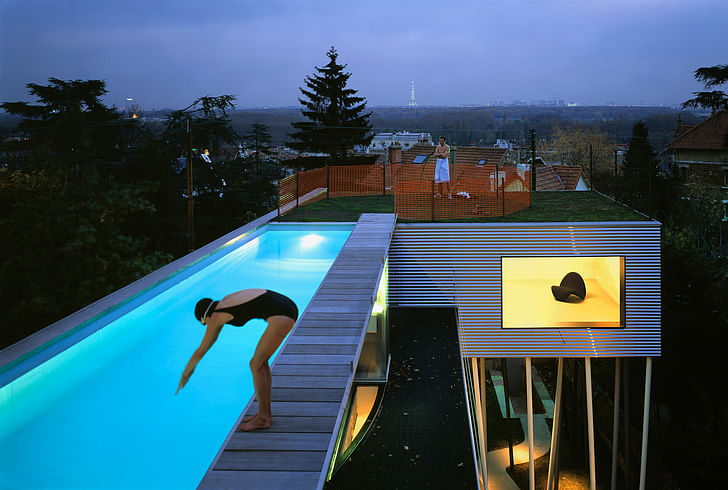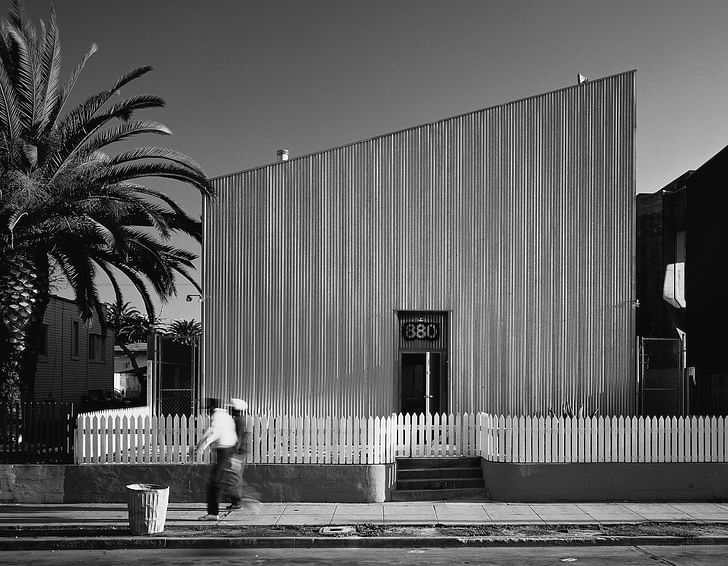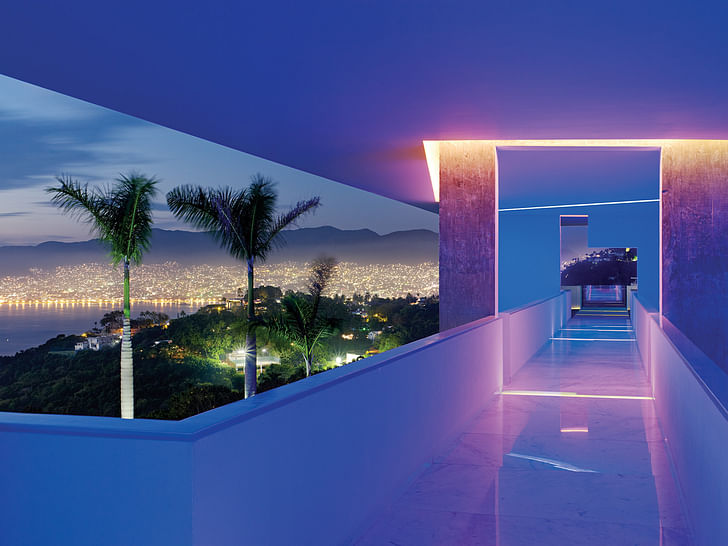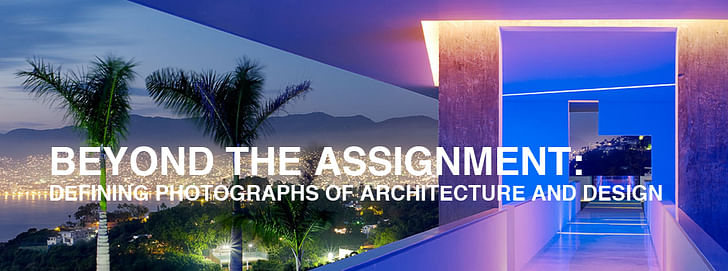

There’s no denying that architectural discourse has drastically expanded with the ease of image-sharing technology. Without even being in the same country as a building, anyone feels entitled to form an opinion of that structure based on photographs that are perpetuated over the internet, to the point where they almost become a stand-in for the actual structure. But the images that reach this singularity are rare, and may only achieve this state through carefully orchestrated harmony with their building-subjects.
In addition to what the architect accomplishes in the physical space, architectural photographers are constructing our impression of the built environment on the mental and virtual planes. According to architectural photographer Bilyana Dimitrova, formerly Metropolis Magazine’s photo editor, “successful architectural photography can make lasting visual impressions that ingrain the built environment in our minds, enabling a given project to live on after the life of the architect and even after the life of the project itself.” It follows then that, in addition to what the architect accomplishes in the physical space, architectural photographers are constructing our impression of the built environment on the mental and virtual planes. Too often, these photographers are ignored completely, overshadowed by the fame of the structure or its architect.
Inspired, in part, by the too-late recognition of architectural photographers Julius Shulman and Ezra Stoller, Dimitrova has curated “Beyond the Assignment”, an exhibition featuring today's architectural photographers from across the U.S., who are nowhere near the end of their careers. Before the exhibition’s October 5th opening at Woodbury University Hollywood Gallery (WUHO Gallery), presented by the Julius Shulman Institute, Dimitrova shared her thoughts with Archinect on the state of architectural photography -- the relationship between architect and architectural photographer, visual storytelling, and how far the field has come.

Archinect: How did you select the photographers to include in the Beyond the Assignment exhibition?
Dimitrova: It wasn't difficult to pick who I wanted in the show once the idea came to me because I have admired so many of my colleagues over the years; some were my mentors and turned me onto the field and of course as a photo editor at Metropolis Magazine I was regularly coming across great talent from across the country. I enjoy looking at the world through pictures, so naturally I am often looking at other photographers' work. Once I knew that the Julius Shulman Institute was interested in presenting the exhibition, the director, Emily Bills, and I discussed the importance of including photographers from the LA area. In addition, even though we look at the work of ten specific photographers, my goal is for the show to be a vessel that focuses our attention on the field of architectural photography and the many photographers working in the U.S. today, [helping] shape how we see architecture and design. Also the youngest generation of photographers can now look back to the field’s long history, and I wanted to represent that through a grouping of photographers from multiple generations. We have Peter Aaron and Paul Warchol who were both mentored by Ezra Stoller, one of the pioneers of the field, and we have myself, Lara Swimmer and Joe Fletcher representing the newer wave of photographers. I also couldn’t have a show that focuses on architectural photography without including at least one photographer each from the two longest standing organizations representing architectural photographers in the U.S. For example, Jon Miller is one of the five photographers of the studio Hedrich Blessing in Chicago, started by Ken Hedrich and Henry Blessing in 1929, and Peter Aaron is one of the seven photographers part of Esto Photographics, Inc. in NY, a photo agency started by Ezra Stoller in 1966.

A: Would you say there is a regional style to the LA-based architectural photographers present in the show?
What unifies the photographers in this exhibition you may call a "style", though for me it is more a “conviction” -- to strive to create images that push beyond the expected, offering inventive and artful ways of looking at the built environment. D: In our field the expression " you are what you shoot" comes up a lot, meaning that the architecture that you shoot defines you and the other way around. What unifies the photographers in this exhibition you may call a "style", though for me it is more a “conviction” -- to strive to create images that push beyond the expected, offering inventive and artful ways of looking at the built environment. Not all architectural photographers working today possess this “conviction”; their pictures leave much to the imagination and inevitably make the projects more forgettable. I first realized this during my time as a photo editor at Metropolis Magazine, prior to that I was only stopping to look at images that inspired me, [but] as a photo editor, I had to look through all of the portfolios that came in each week. I then became aware of the fact that there existed architectural photography that did not make me want to step inside the project, that did not transport me and simply left me unimpressed. Something else to consider is that technical limitations can be interpreted as a “style.” [...] We have a lot more freedom in that regard now and with that a lot more choices to make.

The pioneers of architectural photography ask us to really "look” at the subject, swallow it whole, tell its story in pictures, show its character, its individuality, its essence and even bring it to life! For the photographers in this exhibition, architecture and design is our subject by choice, and we try to show our excitement and curiosity through our images. It's a total cliché of course, but this not just a job for us; we have chosen architectural photography to satisfy both creative and professional pursuits. As a photo editor, I always assigned photographers to shoot projects that I knew they would enjoy shooting because it’s the joy for the work that ends up making the images remarkable. The photographic traditions set forth by our predecessors still hold true because they are a fantastic foundation for making great photographs -- but you first and foremost have to be in your element to achieve them, to then be able to add something of yourself on top of that. The pioneers of architectural photography ask us to really "look” at the subject, swallow it whole, tell its story in pictures, show its character, its individuality, its essence and even bring it to life! A tall order for sure.

A: In what ways is architectural photography different than other forms of photography?
D: Architectural photography is a form of storytelling, involving a series of photographs that are meant to visually narrate the viewer through the project, as if they are there in the flesh. In fact many of us will only experience much of today’s architecture through these types of photographs. Architectural photographers use visual storytelling, technical precision, and a unique visual sensibility to interpret the architect’s vision and define it to the world at large. We are the last piece of the puzzle, responsible for capturing the coming together of everyone’s efforts and all aspects of the design.

A: Is it typical for architects to develop relationships with particular photographers?
We are the last piece of the puzzle, responsible for capturing the coming together of everyone’s efforts and all aspects of the design. D: We are all drawn to people that “get us”, and the same goes for architects and the photographers that capture their work. A photographer that works closely with the same architect over time can internalize that architect’s vision -- very little needs to be said between the two. When there is a common understanding, trust and mutual respect, the possibilities are endless; the photographer feels free to create and the architect feels assured that their vision will come through in the photographs. Once a symbiotic relationship develops between a photographer and an architect, it tends to last a lifetime. Some architects pick photographers that will help elevate their work, especially if the photographer is more established than the architect. In this case the photographer can help the architect come into bloom, so to speak.

A: Do you feel that the art of architectural photography is overshadowed by the attention given to the captured architecture?
D: There is such a symbiotic relationship between the two. Architectural photographers are active contributors to the dialogue of architecture design and, through mass media, help shape how the world sees the built environment at large. So it is especially hard for me to see how little we are brought into the conversation. We are more often than not hidden behind the projects that we shoot or receive recognition towards the end our careers, as in the case with Julius Shuman, Ezra Stoller and others. Because I am a photographer I always duly note the project and the photographer behind the image and I wish that the architecture community more frequently shared this point of view. It often seems that once the image is created and disseminated to the world our role diminishes to a small byline. I could never say that the architecture overshadows our efforts because it is our muse. In "Beyond The Assignment" we look at photographers that have all chosen architectural photography as a way to satisfy both creative and professional pursuits, who not only expertly document but also artfully interpret the built environment.

A: Describe the relationship between architectural photography and architectural filmmaking.
Renderings are instrumental in helping us understand the concept, whereas architectural photography is instrumental in helping us understand the finished project. D: Architectural filmmaking is a great supplement to architectural photography, and has become a useful tool to tell the story of projects with complex and multi-layered stories. Once digital cameras started to have the capacity for high quality video, it became something that both photographers and our clients wanted to explore. The demand for video was also peaked by the rise of publications having both print and online versions; video was something they couldn't offer in print and the addition of it online was a great way to increase their traffic. Time lapse video has become especially popular because it is a great way to show how people move through a space, or how natural and artificial light illuminate the space from morning to night, and we see a lot of time lapse being used to show projects being constructed from the ground up [...] I don't think that video is a necessary component for the documentation of every project, but it definitely shows how our field continues to change with the times, in order to tell fuller and all-encompassing stories of the built environment.

A: Do you think architectural drafting and rendering styles have influenced architectural photography?
D: I think that most architectural photographers were a bit worried for the future of our field the minute photo-real renderings became so good that they were passable stand-ins for the real thing. Luckily we were quickly calmed by the fact that renderings, no matter how like a photo they are, show the project in its concept phase and do not show it in the real world. This is a big distinction, and one that ensures the continued need for architectural photography. Architects can’t win most design competitions on their concepts alone, and need to show how their project actually turned out and how it interacts with its surroundings. Before a shoot, I enjoy having the renderings to review, but it can often be a pretty comical process. I often find myself saying, “I like that perspective and if I could only knock out the wall behind me, I could get that angle for you.” Since I can’t move or see through walls like a computer program can, most renderings are impossible to recreate in the real world. Renderings are instrumental in helping us understand the concept, whereas architectural photography is instrumental in helping us understand the finished project.

A: What do you want people to learn from this exhibition?
This exhibition is a rare opportunity to put us in the forefront, and show how we strive to make indelible images that make the architecture unforgettable. D: The exhibition aims to go against the norm of recognizing architectural photographers at the end of their careers, as in the case of Julius Shulman, Ezra Stoller and others. Visual Acoustics, while a terrific film, was made when Shulman was in his 90s and released the year before he died. The book Balthazar Korab: Architect of Photography was released in 2012, also the year before Korab died. "Beyond The Assignment" brings into focus the photographers that are actively contributing to the dialogue of architecture and design today, none of which are anywhere near the end of their careers. As architectural photographers we are often hidden behind the projects that we shoot; this exhibition is a rare opportunity to put us in the forefront, and show how we strive to make indelible images that make the architecture unforgettable.

Presented by the Julius Shulman Institute at Woodbury University, "Beyond the Assignment: Defining Photographs of Architecture and Design" will be at the WUHO Gallery October 5 - November 1, 2013.
A panel discussion will take place in conjunction with the exhibition's opening at Los Angeles Contemporary Exhibitions (LACE), 5-6pm on October 5.
Former Managing Editor and Podcast Co-Producer for Archinect. I write, go to the movies, walk around and listen to the radio. My interests revolve around cognitive urban theory, psycholinguistics and food.Currently freelancing. Be in touch through longhyphen@gmail.com
Are you sure you want to block this user and hide all related comments throughout the site?
3 Comments
Dennis Hopper House is by Brian Murphy aka BAM Construction. I liked the way Tim Street often worked with a handheld camera.
I would also be curious about the commerce and its symbiotic relationship with the architectural photography? How does one negotiate the relationship between two adjacent pages in a magazine both using and architectural photography of a similar subject (a house, a building.) As one selling a dream and the other selling a component of that dream, a high end window line, for example.
I asked this question to Julius Shulman once and he said "it didn't use to be like that."
@Orhan this graph speaks somewhat to your question no?
"Some architects pick photographers that will help elevate their work, especially if the photographer is more established than the architect. In this case the photographer can help the architect come into to bloom, so to speak"
Archinect
This is your first comment on Archinect. Your comment will be visible once approved.